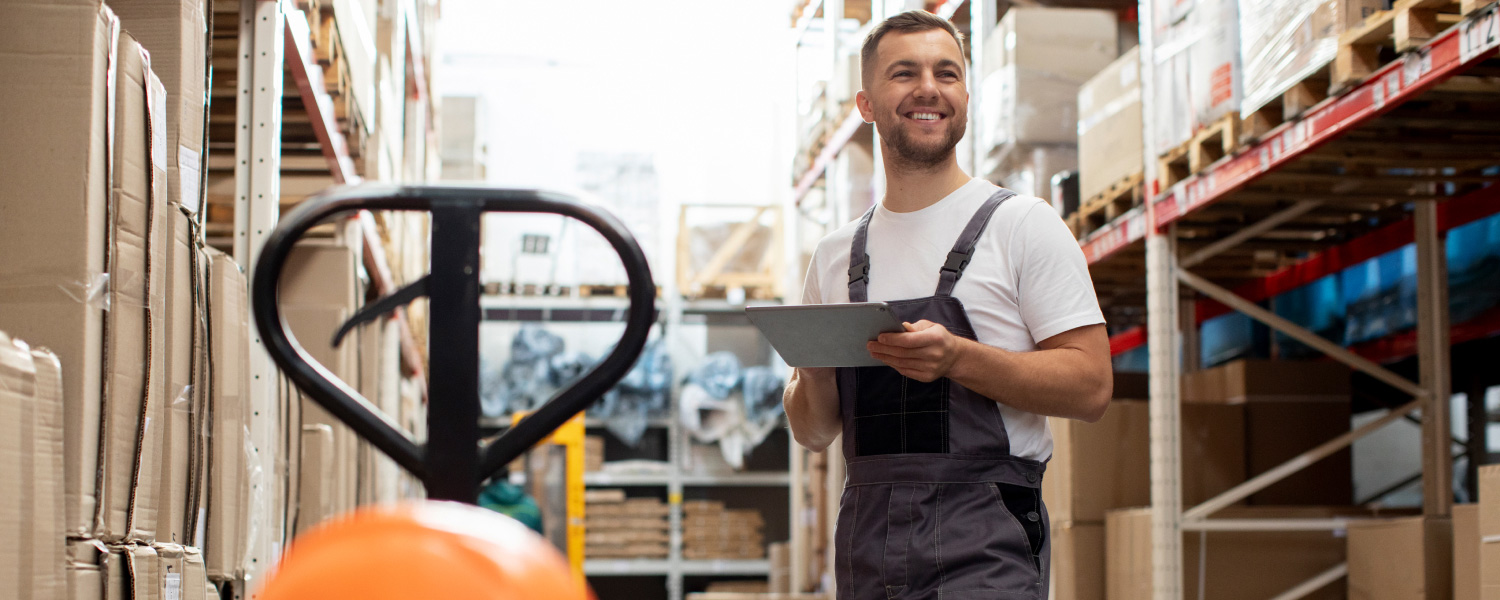Have you noticed how quickly traditional warehouse methods are fading away?
2018 marked a major shift as the use of paper-based picking systems dropped from 62% to just 48%, dipping below half for the first time.
At the same time, over 90% of warehouses have now adopted 3PL warehouse management systems (WMS).
That’s right, technology isn’t just at our doorstep; it’s completely redefining how we manage logistics.
This sweeping change highlights a move towards more streamlined, tech-driven operations, significantly boosting efficiency and accuracy in warehouses.
As we get deeper into the dynamics of modern logistics, it’s clear that integrating a 3PL warehouse management system isn’t just a trend, it’s a crucial step forward.
Let’s find out why choosing 3PL warehouse management systems is essential for staying competitive and efficient in today’s fast-paced market.
What is a 3PL Warehouse Management System?
A 3PL warehouse management system (WMS) is specialized software designed to help third-party logistics providers manage and optimize their warehousing and distribution operations.
This type of WMS streamlines various aspects of warehouse management, such as inventory tracking, order fulfillment, shipping, and receiving.
By using a 3PL warehouse management system, logistics providers can efficiently handle multiple clients, each with their own unique inventory and operational requirements, within a single system.
Essentially, a 3PL WMS is crucial for helping logistics companies offer their clients reliable, scalable, and flexible warehousing solutions.
Common Challenges Faced by 3PL Warehouses
Running a 3PL warehouse isn’t without its hurdles.
Whether you’re managing inventory for multiple clients or dealing with fluctuating demand, here are some common challenges that can make day-to-day operations a bit tricky.
1. Managing Diverse Client Inventories
According to 62% of respondents, the primary cause of issues in inventory fulfillment is human error resulting from manual process management.
One of the biggest challenges for 3PL warehouses is managing the inventory for multiple clients under one roof.
Each client may have different requirements, from specific packaging to varied stock levels, making inventory management a complex task.
Keeping everything organized and accurate can be a real test of your warehouse’s capabilities.
2. Ensuring Accurate and Efficient Order Fulfillment
Order fulfillment is the heart of warehouse operations, and getting it right is important.
However, when you’re dealing with high volumes of orders, even a minor mistake can lead to delays or unhappy customers.
Ensuring accuracy while maintaining efficiency is a constant balancing act that requires attention to detail and effective processes.
3. Keeping Up with Technological Advancements
The logistics industry is rapidly evolving, and staying on top of the latest technology is essential for remaining competitive.
But, implementing and maintaining new systems can be challenging, especially when resources are tight.
The pressure to adopt cutting-edge tools while managing daily operations can be overwhelming for many 3PL warehouses.
Understanding Why Warehouses Need 3PL WMS Software

In today’s fast-paced logistics environment, third-party logistics (3PL) providers face increasing pressure to manage complex operations efficiently.
With multiple clients, varying inventory demands, and the need for accurate order fulfillment, traditional methods are no longer enough.
This is where 3PL WMS software comes into play. But why is it so essential for 3PL warehouses?
Let’s explore how a 3PL WMS software can transform your operations and help you stay competitive in the ever-evolving logistics landscape.
1. Improved Visibility
Visibility is always a top priority for customers.
Common Customer Questions
- They want to know how many orders have been shipped each day, what their current inventory levels are, and when it’s time to reorder products.
- They might also need to track which products are moving the fastest and where specific orders are in the process.
These are the questions your customers face daily, and with a WMS, you can provide all the answers without needing a phone call or email.
Here’s how a WMS enhances visibility:
- Customers can monitor inventory levels, order statuses, and product movement in real time, ensuring they always have the latest information.
- The system automatically alerts customers when orders are dispatched or when stock levels reach a critical point, helping them make informed decisions quickly.
- A warehouse management system allows your 3PL warehouse to offer virtual access through a customer portal, giving customers real-time updates on their products.
This level of visibility is exactly what your customers expect and Teamship’s 3PL WMS can give you that competitive edge in the marketplace.
2. Greater Flexibility
A well-designed WMS doesn’t just guide your workforce in order fulfillment; it also seamlessly integrates with other software systems, ensuring your operations remain highly adaptable.
This integration allows your warehouse to coordinate more efficiently across different platforms, giving you the agility needed to make quick operational changes, such as adjusting task sequences to accommodate last-minute orders.
Find out how a WMS can improve adaptability
- Seamless Integration: The system connects with various software platforms, enabling smooth coordination and streamlined workflows.
- Real-Time Adjustments: It allows for quick changes in task priorities, ensuring you can efficiently manage unexpected order requests or shifts in demand.
Teamship’s scalable 3PL warehouse system offers this flexibility, helping you stay responsive and adaptable in a fast-paced environment.
3. More Data-Driven Insights
Ever wonder what really impresses a customer when you’re pitching your services? It’s all about showing them you’ve got their needs covered with solid data.
Imagine walking into a pitch and presenting detailed reports that highlight your warehouse’s throughput pace by employee over the past three months. That’s the kind of information that builds trust and confidence.
When you’re making a sale, having data to back you up is essential.
With a 3PL warehouse system, everything you do is tracked, allowing you to generate reports on key metrics like Item Aging, Inventory Turns Analysis, and live order status.
It’s worth noting that only 31% of organizations today are truly data driven.
By leveraging your WMS to provide actionable insights, you’re not just offering a service, you’re positioning yourself ahead of the majority, giving your clients the data-driven support they need to succeed.
4. Advanced Automation Capabilities
A WMS can seamlessly integrate with advanced technologies like robotics, AI, and IoT devices, taking warehouse automation to the next level.
For example, by connecting your WMS with automated guided vehicles (AGVs) or robotic picking systems, you can significantly speed up order fulfillment and reduce labor costs.
AI-driven algorithms can optimize picking routes and warehouse layouts, minimizing travel time and boosting efficiency.
Additionally, IoT sensors can monitor equipment health and inventory conditions in real-time, allowing you to proactively address maintenance issues and prevent costly downtime.
5. Higher Sustainability and Resource Optimization
Have you ever walked through your 3PL warehouse and noticed that some areas are underutilized, while others are overcrowded with inventory.
You know there’s a better way to organize things, but where do you start? This is where a WMS becomes your partner.
By providing a holistic overview of how every square foot of your warehouse is being used, the WMS helps you make smarter decisions. Want to know how?
- By analyzing space utilization data, you might discover that simply reorganizing your storage areas could maximize capacity, potentially eliminating the need for additional warehouse space.
- The WMS also tracks energy consumption patterns, revealing opportunities to cut down on electricity use—like optimizing lighting and HVAC systems during off-peak hours.
- Lastly, by keeping inventory levels just right, the system helps you avoid overstock, reducing waste and minimizing your environmental footprint.
The result? A more sustainable operation that not only benefits your business but also the planet.
Get Teamship’s WMS for Your 3PL Warehouse
Imagine running your 3PL warehouse with complete confidence, knowing that every order is processed smoothly, your inventory is perfectly managed, and pricing is always on point. That’s what you get with Teamship’s WMS, a system designed to make your life easier and your warehouse more efficient.
Here are three features that set Teamship’s WMS apart:
Pick and Pack Fulfillment
Streamline your order processing with our easy-to-use pick and pack system, ensuring accuracy and speed in every shipment.
Unified Inventory Ecosystem
Manage all your inventory across multiple locations from a single platform, giving you real-time visibility and control.
Warehouse Pricing Wizard
Optimize your pricing with our smart RFQ wizard, helping you set competitive rates that align with your operational costs.
Schedule a demo for Teamship’s WMS today and see the difference for yourself!
Final Thoughts
In today’s fast-paced logistics world, 3PL warehouses need to stay on top of their game to meet client demands.
A Warehouse Management System (WMS) is more than just a tool—it’s essential for running an efficient operation.
By simplifying processes, keeping inventory accurate, and making sure orders are fulfilled quickly, a WMS helps 3PL warehouses stay competitive and responsive.
As the industry keeps changing, having a reliable WMS in place will help you handle whatever comes your way.
It’s a smart move that can lead to smoother operations and long-term success.
Frequently Asked Questions
1. Why use a 3PL warehouse?
One of the biggest benefits of using a 3PL is that it helps boost speed and efficiency.
As your business expands, a 3PL can manage higher order volumes without requiring you to hire more staff.
Plus, they use their extensive networks to negotiate better shipping rates and speed up delivery times.
2. What is the difference between a warehouse and a 3PL?
A self-operated warehouse gives you space to store your inventory, but it also means you’re responsible for coordinating product movement, packaging, and shipping.
On the other hand, a 3PL handles these tasks for you, offering a more streamlined and integrated service.
3. What is the objective of 3PL?
The main goal of the 3PL company is to make your supply chain more efficient and to enhance the overall performance of your operations.
Beyond basic services, a 3PL provides additional support like custom packaging, labeling, handling returns, managing customs, and offering supply chain consulting.

